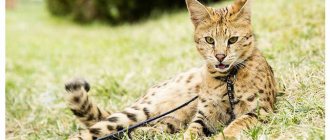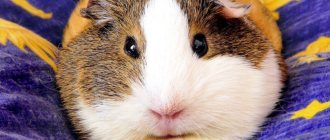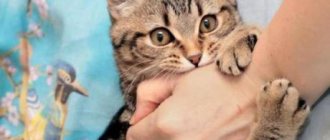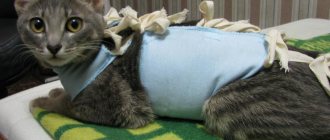Little cats - big story
In 1831, the French naturalist Isis Saint-Hilaire obtained a small spotted skin. Having carefully examined it, he decided that it belonged to an animal unknown to science, which he named Prionailurus rubiginosus (rusty) because of the spots that resembled rust. Since then, the rusty cat became known not only to zoologists, but also to everyone who was in one way or another familiar with the works of this scientist, who made the first detailed description of the rusty cat.
It is not surprising that the animal aroused keen interest among everyone who wanted to see it in its natural habitat. But viewing a wild purr in natural conditions, much less taking a photograph of it, has always been extremely difficult.
To capture the animal, you will have to go to Sri Lanka, Nepal or India, but it is not a fact that you will be able to film the cat, because it comes out of hiding to hunt only at night. Moreover, he steps so quietly that he hardly makes any rustling sounds. So the very first photograph of a cat was taken only six years ago in a national park in Nepal.
It is noteworthy that for this purpose, as many as thirty-seven hidden cameras were installed in the park, and only one of them took the picture.
Now there are few rusty cats left on our planet, approximately 10,000 individuals. Therefore, rusty cats are listed in the Red Book. Hunting these cats is prohibited in Nepal and India.
What is she like, a rusty spotted cat: appearance, character, habitat
The ginger cat, at first glance, is a very cute creature, wearing a soft fluffy coat of brownish-gray color with undercoat. Indeed, people should not fear anything when meeting her. Due to its small size, it could not cause harm, even if it wanted to.
Appearance
Since the cat comes from approximately the same region as the Bengal, their colors are somewhat similar. If in Nepal and India red tones predominate in the color, then in Sri Lanka more gray is “added” to it, the cats’ fur is grayish-red.
On the neck and belly of the animal, the fur is white with yellow stripes and spots. Four thin dark stripes stretch from the eyes to the ears, ending at the spine. The ears are large, widely set and rounded at the ends. The eyes are also large, bulging, orange or yellow.
The pads on the paws are black, the whiskers are half white, half black. The length of the tail reaches 30 cm.
She has the same slender and agile, but small body. Males grow up to 1.6 kg, and females are even smaller.
Populations
So far there are only two types of animals. Some live in India, others in Sri Lanka. The main difference is the color. In the Indian cat, red tones predominate, while in another species, gray tones predominate.
Character
The rusty cat is a true fearless hunter. Despite its small size, it is not only ready to defend itself to the end, but also to attack large game.
There is a known case when an animal, whose weight did not reach two kilos, rushed at a roe deer, grabbing its neck. This incident was witnessed by the famous scientist Thomas Jordan. It is noteworthy that the cat was tamed and lived with people.
Interestingly, cats are very friendly towards people. Adult cats do not bite, even if they are caught and locked in a cage. And they only rush around in fear, trying to get out. But kittens that people tame at an early age adore them and completely trust them. .
There is a known case where two kittens of a rusty cat were tamed by an employee of the Indian National Park. They slept in his tent in a basket with bedding. Despite the fact that they moved freely through the jungle, each time the brothers returned home.
As they grew older, they also expressed their love and trust. While the owner was working, one of the kittens slept on his lap, and the second sat on the back of a chair and hugged the scientist with his paws.
Unfortunately, one of the kittens was bitten by a snake and died, even though the owner did not try to save him. Then a new playmate was brought to the wild kitten, an ordinary domestic kitten.
At first the savage did not recognize him and hissed, but later he became friends. However, the pet could not replace his deceased brother. He could not climb the banyan tree so quickly and high, and he began to scream as soon as he climbed a little higher into the tree, and he had to be removed from there. Therefore, the rusty kitten gave in to his “underdeveloped” domestic brother and ran around with him more on the ground. He almost didn't climb the trees.
Rusty cats live in many zoos, and keepers do not have any problems. Despite their love of hunting, they never attack humans. If you take a baby rusty cat, he will be as affectionate and playful as any pet.
Dune or desert
Dune (desert) cat
Distribution: North Africa, Arabia, Iran, Southern Morocco and Central Asia. As the name suggests, these cats live in the desert. Ideally adapted to difficult conditions, they are small in size: the body is from 65 cm to 90 cm, and up to 40% is occupied by the tail. The head is short, wide, flattened, with sideburns. They are nocturnal animals that hunt by ear. Therefore, they have very large and wide hearing organs. They don't have tassels. The eyes are yellow in color, very sharp, with a slit-like pupil.
The paws are large and strong. In search of prey, these desert inhabitants travel up to 8 square meters. km per night. There is dense fur on the paw pads, which saves the owner from burns on the hot sand. The color of the Central Asian species is somewhat different from the African one. In summer it is yellowish, and by winter it changes to gray. The fur thickens and lengthens to keep the animal warm in winter frosts.
The main food is birds, rodents, and non-venomous snakes. The main hunting technique is an ambush attack: the victim is grabbed by the neck and shaken violently. A feature of this type of cat is the ability to do without water for a long time: they receive the necessary moisture from food.
Advantages and disadvantages
As already mentioned, wild cats quickly become attached to their owners, but require certain conditions for keeping in captivity. Therefore, if you decide to purchase a wild beauty, keep in mind that it has its own advantages and disadvantages.
The advantages, of course, include small size, which causes affection, unusual appearance, easy care, great activity and playfulness. A significant plus is attachment to the owner and devotion.
But still, these are wild cats and they can sometimes be aggressive. Although the owners are not in serious danger, pets sometimes hiss and bite. The apartment is not suitable for their maintenance. They need an enclosure where they can feel at home.
Therefore, cats are more suitable for keeping in country houses. And the price for them is steep.
Sarah – 33 years old
The gray and white cat lived for more than 33 years, gaining fame. She became famous as "New Zealand's Oldest Cat". One can only guess how much her owners loved her. Look how interesting her eyes are, revealing her serious character! Sarah was probably a capricious cat.
Interesting fact: a cat in New Zealand was declared a kleptomaniac - in 2 months she stole at least 60 items of men's underwear. She stored her trophies in the backyard of her master's house. The cat Brigit showed her passion before, when she lived with her owners in another city. I wonder why she was so attracted to things from the men's wardrobe?
Habitat
The natural habitat for cats is forests, rocks, meadows. They can also settle in tea and coconut plantations, rice fields, etc.
The only countries where they are found are Sri Lanka, Nepal and India. For example, in Northern India they live in the state of Uttar Pradesh, and are also found in Western Maharashtra, the western Ghats and the Varushanad valley. Another region where they live is the state of Gujarat, where there are dry and tropical forests.
There are also two reserves where rusty cats can be found: Nugu (Karnataka), Nagarjuna Sagar Srisailam (Andhra Pradesh Tiger Reserve).
Cats do not always live in forests. If there are rodents nearby, the animals take up residence in abandoned houses. For example, they can often be found in settlements in southern India, located at great distances from forests.
Menu
The rusty cat's favorite treat is small rodents and birds. Residents of India saw that rusty cats hunt mice and frogs that appear after the winter rains. If given the opportunity, a rusty cat may attack poultry, chickens and ducks.
At the zoo, the diet of animals is different. So in Frankfurt they are fed beef, beef heart, chickens, mice. The menu also includes vegetables, apples, and boiled rice. Sometimes they are given fish and bananas.
If a cat lives at home, in addition to meat and fish, she should be given egg yolks, fermented milk products, and greens.
Diet
In nature, the ant tiger's menu includes:
- larks;
- locusts;
- gophers;
- long-eared mice;
- spiders;
- gerbils;
- termites;
- lizards;
- butterflies;
- fresh and dry grass.
Note! If you're lucky, even a bustard, hare or anteater can become prey. During the night, a cat eats up to 300 g of food, and sometimes more.
Scientists recorded that one small predator ate 450g overnight, which was more than a fifth of its weight. This appetite is due to the high metabolic rate
During the night, a cat eats up to 300 g of food, and sometimes more. Scientists recorded that one small predator ate 450g overnight, which was more than a fifth of its weight. This appetite is due to the high metabolic rate.
It is advisable to minimally disturb the natural biorhythms of the ant tiger. There is no need to transfer the animal's activity to the daytime. Therefore, feeding is carried out at night every 40-50 minutes. in small portions. Most of these desert inhabitants prefer meat along with sinews and cartilage tissue. Chicks and quails are given with their feathers. Fresh meat is supplemented with industrial feed and boiled eggs. To create a proper balanced diet, it is better to consult a veterinarian.
Important! It is not advisable to give fish, since it is not part of the predator’s natural diet. After a successful hunt, the animal can bury the prey
After a successful hunt, the animal can bury the prey
Mating and offspring
During the mating season, male rusty cats are allowed to be in the territory of females, and vice versa. As for zoos, the female remains in the male's territory even after she gives birth to her babies. In one of these establishments, the male even attacked the attendants who were feeding the cats, because he believed that his offspring needed protection.
In the natural environment in India, kittens are born in the spring, after 67 days of mother's pregnancy. As a rule, this happens in a secluded lair, a cave.
In Sri Lanka, tree hollows or small caves under rocks can become breeding grounds. An hour after the babies appear, the mother leaves them for a while, going in search of food. After about a month, the kittens also begin to leave their shelter, and after 40 days they are already able to climb trees, and at 50 they can jump from a height of two meters.
Most of the time they play and sleep near their mother, as they get tired very quickly. Up to 40 days, babies eat only milk, then the diet is replenished with meat.
Reproduction
Cats gather together between the beginning of January and the end of March. Males in groups begin to hunt for the mother of their future offspring. In addition, the female is often pestered by simply stray cats who also want to mate with her.
Males fight among themselves from time to time. Fights occur both between males of the same species and with outbred cats. But in the end, not all the offspring turn out to be “pure”, since many females manage to mate with outbred males.
When a female becomes pregnant, she begins to look for the best place for the subsequent birth and maintenance of offspring. Cats very often settle in holes and hollows abandoned by their previous owners.
The female brings grass and feathers into the home, thereby making a kind of pillow for her children. She gives birth in 2 months, sometimes a little more time passes, but still the birth occurs in the spring - in April or May. Usually only 2-3 fluffy lumps are born, occasionally 4-5.
Newborn forest kittens are very weak and small, they weigh 200-300 grams. Therefore, the mother has to monitor them and feed them milk.
At the age of a month, babies begin to slowly get comfortable and crawl around the house (at this time the cat should be especially attentive). At two months of age, kittens leave the house and go hunting with their mother. After this, the still small wild kittens begin to try to exist on their own, but their mother does not abandon them.
Enemies of the Rusty Cat
Oddly enough, in fact, the main enemy for cats is people who cut down forests, disturbing their habitat. Cats can be destroyed if they actively steal poultry, despite the fact that the animals are listed in the Red Book. In some regions, cats are even eaten, and their meat is highly valued.
As for predators, it is not yet known whether larger animals can be dangerous to cats. But this is quite possible.
Spotted cat health
Rusty cats were not subject to mutations and are in excellent health. They have excellent immunity, high resistance to stress, and are extremely resilient, as they are forced to survive in the wild. Not a single domestic pet is capable of climbing a tree so quickly and rushing at prey that is larger than a cat.
Scientists say that cats that live in zoos around the world are not prone to disease. The only thing that can seriously undermine the health of cats with rusty spots is an incorrectly formulated diet.
However, when cats are not in a natural environment, their immunity decreases. In zoos they are given vaccinations. The procedure should also be carried out if you keep your cat at home. Therefore, they receive vaccinations according to the schedule drawn up by the veterinarian, just like other cats.
If a cat is properly cared for, it can live up to 12 years at home. And in nature – up to 15 years.
Animals remain in good physical shape until old age. It’s just a pity that these beautiful little animals are becoming fewer and fewer in their natural habitat due to poaching and narrowing of their habitat.
Origin of the species
This is a wild variety of the Asian cat, a close relative of the Bengal (precisely wild, do not confuse it with the domestic one).
The spotted-red cat is considered the smallest representative of the cat species in Asia; in Africa it is the Black-footed cat, which is almost the same size.
The weight of an adult Rusty cat is from 900 g to 1.5 kg. The maximum body length without tail is 47 cm. A medium-sized animal can easily fit in the palm of an adult man.
The first mention of this cat species in specialized literature dates back to 1831.
Can a rusty cat live in captivity?
For many years now, cats with rusty spots have been living in various zoos around the world, but their conditions there are as close to natural as possible. Currently, about 60 cats from India and Sri Lanka live in 9 zoos. Prionailurus rubiginosus can be seen at the Paris Zoo, Ostrava (Czech Republic). In Frankfurt (Germany), Cincinnati (USA) they successfully breed these amazing animals.
As for the homeland of spotted cats in India, they have adopted a special program for breeding animals in zoos. Local people in India often domesticate animals, and they live next to humans, almost like cute pets.
What is needed to keep a wild cat at home?
If you decide to get a wild rusty cat, an ordinary apartment and the conditions that are usually offered to domestic pets will not be suitable. For the kitten you will have to make an enclosure fenced with a net. Its height should be at least three meters, and bamboo, ficus and other tropical plants should be planted inside.
It is important to maintain the temperature at least 30 degrees. If the cat is cold, it will die from hypothermia. For this reason, she can live in an outdoor enclosure only in the summer, and in the winter she must “move” to a room that is well heated.
The “environment” in the enclosure should be the same as in the forest of India. It’s good if there are logs in which voids have formed. This is an ideal option for cats to hide. But if there is no such material, then you will have to build a “cat house”: make something like a pipe with several exits from the boards.
A linen bedding, preferably burlap, is placed in the house. One piece of fabric is cut into two parts so that one can be put in the house and the other can be left for replacement. Cats do not like and are afraid of new smells. Therefore, while you wash one bedding, exactly the same one will lie in the shelter.
How to keep a predatory animal?
Wild pets will happily eat live meat from birds, mice, and even insects. The diet may include poultry and small rodents. Vitamins are needed. The animals are fed for six days, and on the seventh they are left without food, since they must fast for one day. You should play with kittens more when they begin to get used to their owner and get accustomed to their nickname.
If you want to start breeding animals, you should follow the example of the zoo workers from Frankfurt. You need to take a boy and a girl from different cats when they are no more than 3 months old, and raise them together.
Finding a mate for an adult cat is much more difficult, since cats are loners by nature. There is too high a chance that they will not get along and the couple will not work out.
Characteristics of servals
A wild cat that becomes a domestic cat leaves behind a funny character. The cat will show it in all its glory, these will be unforgettable years of coexistence between a spotted bush cat and a human.
The animals have not lost their genes anywhere: they happily hang on any ropes, curtains, or cords. The owner's job is to secure the house.
The serval kitten will happily chew on everything that his gaze falls on. To avoid problems with chewed things, the baby is given a sufficient number of toys.
The character of the pet can be called cunning. If he crosses boundaries, this must be stopped. Stop playing if he bites your hand hard at this time. The cat is smart, the correct conclusions will still be drawn.
Since childhood, a kitten has been playing with any cat toys; as they grow older, they are replaced with dog toys; they are larger and will not get into the respiratory tract.
The serval is dexterous and evasive. It's fun to play with him, but if the cat suddenly shows anxiety, you need to be patient. The pet will learn to feel safe with its owner. You can play tug and fetch.
Cats react negatively to the torture that small children may subject them to.
It is important here that the owner does not allow such situations to occur. The pet will remain calm, and no one will scratch the children in fear
If children do not offend the cat, then the relationship with him will be friendly.
This unthreatening predator will most likely be afraid of guests and hide from them. Well, don’t insist, the cat’s healthy psyche is much more important. As soon as the pet gets used to other people's voices and smells, he himself will show curiosity and come out to look at the strangers.
Since in nature cats feed on small rodents, birds and reptiles, and there are already such pets in the house, introductions should be done carefully and gradually. It’s better to think and weigh who you want to keep in the house more
A smart serval will open the latch on the cage with the bird, but not to ask how it is doing. With an affectionate dog that does not chase cats, a good relationship can develop.
It is better to bring a small cat to a house where pets already live. This option will allow you to hope for the emergence of friendship between all the inhabitants of the house or apartment.
Raising and training a pet
To ensure that upbringing goes smoothly, a kitten is purchased no earlier than 1.5 months, but no later than 5 months. It is best to hand feed your baby; this will build trust in the person.
You need to accustom your cute savage to a leash and collar from childhood. At first they offer a loose collar, but gradually tighten it tighter.
Accustom kittens to wood filler in a tray. They will not bury their litter box, so you will have to keep the tray clean. If the cat went to the toilet in a place other than the litter tray, there is no need to scold it. They immediately explain where to go. The animal understands the dissatisfied tone perfectly well.
global $ads_google; //data-ad-slot=”2475549904″ $ads_google = empty($ads_google) ? false : true; ?> if ($ads_google == false) {?>
If your pet climbs onto the table or misbehaves, you can spray it with a water pistol. This will be a serious warning!
Some interesting facts from the life of rusty cats
Rusty cats “walk by themselves” and are loners, each of them has their own territory, which only cats of the opposite sex can enter during the mating season.
Spotted animals are not afraid of water, swim beautifully and even catch fish, which they love to feast on. Poultry sometimes also becomes prey for cats, which local residents really don’t like. If a cat gives birth to kittens, they will definitely be of the same sex. Usually these are two babies, sometimes three.
Few people have managed to photograph a rusty cat in its natural habitat. So far, there are no more than a dozen photos of rusty beauties that were taken not in zoos, but in nature, and even then after 2005.











